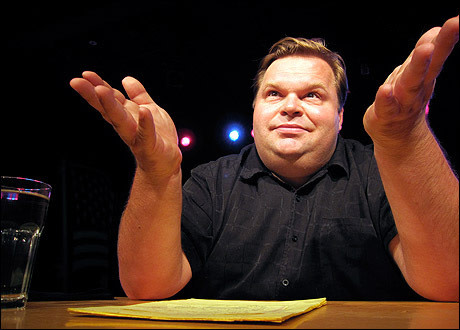TBA 2011: What Mike Daisey Did

1. Did not set a public speaking endurance record—though his audience probably set a record for secular, voluntary attendance.
First, we should say that Daisey never stated an intention to record-break, but he did insinuate that a 24-hour storytelling stint was unprecedented. If you consider Daisey’s convoluted and dreamlike tale, often interwoven with off-topic rants and musings a “story,” then you can probably safely give him the “longest story” win. Unfortunately, another Mike holds the record for longest public speech by one person: Mike Frazier, according to the Guinness Book, preached for 28 hours straight at a Baptist church in 2009. A history-making runner-up is Senator Strom Thurmond, whose exhaustive 24-hour-18-minute no-breaks racist filibuster failed to block the Civil Rights Act of 1957.
Now, Daisey’s audience members stayed put from 6pm Saturday to 6pm Sunday—and that’s certainly rare, if not unprecedented. Qualifiers are such a noisome ointment-fly, we know, but we have to say “secular” to account for the aforementioned Guinness record, as well as for religious cult members, whom anecdotal evidence suggests have long since cracked a one-day record for nonstop listening to a single charismatic leader, whether or not their attendance makes it into any books. We say “voluntary” because we assume that Senator Thurmond’s listeners stuck around out of a sense of duty to their office—not because they hung on his every inflammatory word. Daisey’s audience did hang, and seemed willing to follow him anywhere—to the flagpole for a fire drill, to the farthest reaches of credulity, and beyond the established boundaries of their own sleep schedules and attention spans.
2. Used classic campfire trickery to push “time and place” tie-ins to the hilt.
Are you familiar with the campfire ghost story about the man with a hook for a hand? Despite infinite variations, the teller of this tale always manages to mention: The hook-handed maniac attacks campers just like us, on nights just like this, in places like this. Maybe he’s even attacked right here before, and (most importantly) I think I can hear him coming right now! (At this point, ideally, the storyteller finds some way to create a noise to alarm the audience). In the same vein, Daisey created the sense that his characters were close at hand. Though they started out in New York and Seattle, he eventually turned their getaway car toward “the Duration-Based Art Festival, or DBA,” in Portland. He suggested that they’d snuck into the wings of the theater, and that one of them had pulled the fire alarm (which had gone off earlier, conveniently forcing the audience awake and outside for a minute, but suspiciously failing to summon fire personnel.)
3. Approximated the experience of a long lucid dream.
We’re here—no, wait, we’re at Disney World—and so is David Bowie, only he’s also Nicolai Tesla. And I suddenly wake up as a woman—actually, a hooker in Dusseldorf. By combining characters, distorting timelines, introducing celebrities uncelebrated into the increasingly implausible fray, and creating a vague and illogical impression of an urgent quest, Daisey’s narrative imitated the style of a more famous storyteller: The Subconscious. There were only two possible responses: pinch yourself, or just go with it.
4. Did not maximize Daisey’s amazing gift for nonfiction, nor culminate in a call to action.
Last year in The Agony and Ecstasy of Steve Jobs , Daisey recounted the injustices of the modern Mac manufacturing process, culminating in an earnest plea for audience action (Write to Mac, visit a suggested website, change your consumer choices…) But in this year’s performance, Daisey flirted with his trademark anti-corporate sentiment, suggesting that Disney and Ikea were—if not entirely evil, at least not to be trusted—but he didn’t commit. He recounted some of his deep research about Disney, and some of his shallower appreciation for Ikea, without ever spelling out a solvable problem. “But, Mike,” some devotees might cry, “what should we do? Sue Disney for false magic? Buy a generic Ikea-compatible wrench from an anarchist local parts manufacturer?” Daisey didn’t say, seeming to imply that this time we should just enjoy our collective disgruntlement, accepting his gripes as credible, even while we inherently understood that the rest of the narrative about David Bowie and Obi Wan Kenobi was a wild and far-flung fiction.
5. Ominously foreshadowed the narrator’s surrender.
In the closing scene of Shakespeare’s The Tempest, the wizard Prospero makes a heart-felt speech that doubles as an incantation, removing his powers and turning him into a regular mortal man. Daisey seemed to read from this page, claiming that he’d split his palm open and spilled his blood on the stones of Disney’s Magic Kingdom, thereby surrendering his storytelling gift. He suggested that he couldn’t even finish the story he was now telling, since performing this reverse-Blarney-stone ritual had already divested him of his gift of gab. Earlier, while toying with a very real gun on his desk and describing prior suicide attempts, Daisey had checked himself: “But I want this too much. To be here, with you.” It’s doubtful that Daisey will quit anytime soon, but the implication certainly added a layer of urgency for the crowd that loved him so.
For more about Portland arts events, visit PoMo’s Arts & Entertainment Calendar, stream content with an RSS feed, or sign up for our weekly On The Town Newsletter!
